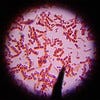Are those your cooties? MDR-bug transmission rates in ICUs

(image: flickrCC)
Foam in, foam out, gown on, gown off ... ah, the tedium of practicing critical care medicine in the age of rampant, lethal, multi-drug resistant bacteria.
As a reminder to keep your guard up and your gear on, here's a yucky study from Daniel Morgan, Elizabeth Rogawski, and Anthony Harris of the University of Maryland and UNC-Chapel Hill, in the April 2012 Critical Care Medicine.
What They Did
Authors used standard surveillance techniques to swab-culture the hands (with and without gloves) and isolation gowns of health care workers as they went in and out of the ICU rooms during 585 interactions with 36 patients at U. of Maryland. Patients were on contact precautions for multi-drug resistant bacteria colonization or infection (MRSA, Pseudomonas, Acinetobacter, and vancomycin-resistant Enterococci). The professionals included everyone who works in the ICU (nurses, doctors, respiratory therapists, etc).
What They Found
Overall, 120 of 585 interactions (21%) with 36 patients infected or colonized with MDR bacteria resulted in a positive culture obtained from the health care professional's skin, glove, or gown. Fortunately, most of the positive cultures were obtained from the protective gear that went into the trash.
The most promiscuous bug at the U. of Maryland was Acinetobacter: 33% of the professionals' gowns and/or gloves were contaminated with MDR Acinetobacter after a contact with a colonized/infected patient.
14-17% of workers' gowns or gloves were contaminated with each of the other pathogens (MRSA, Pseudomonas, or VRE) after each contacting an infected/colonized patient.
Only 1-5% of professionals' ungloved hands were contaminated before going into the room. (These contacts were excluded from further analysis.)
About 1-5% of workers' hands were likely contaminated on any given MDR bacteria-colonized patient contact (i.e., they were culture-negative before going in, and culture-positive after).
Now, the bragging rights I know you're all waiting for. Of all of the ICU worker bees, who had the most cooties? Doctors? Nurses? Housekeepers? Perhaps to the benefit of ICU workplace relations, no profession stood out as the most likely cootie-carriers in the analysis.
More constructively, authors identified several risk factors that increased the likelihood of health care worker contamination with multidrug resistant bacteria:
Positive MDR-bacteria culture of surfaces in the room: 4.15 odds ratio for HCW contamination.
Spending > 5 minutes in the room: 1.99 odds ratio for contamination
Examining the patient: 1.74 odds ratio
Touching the ventilator: 1.78 odds ratio
Compliance with isolation precaution (wearing gowns and gloves) was not assessed here -- all the interactions took place while the workers were wearing protective gear.
Epidemiologic patterns of MDR-bacteria colonization, infection and transmission vary widely, even between ICUs in the same city; these findings might or might not be replicated at other regions or medical centers.
Morgan DJ et al. Transfer of multidrug-resistant bacteria to healthcare workers' gloves and gowns after patient contact increases with environmental contamination. Crit Care Med 2012;40:1045-1051.


